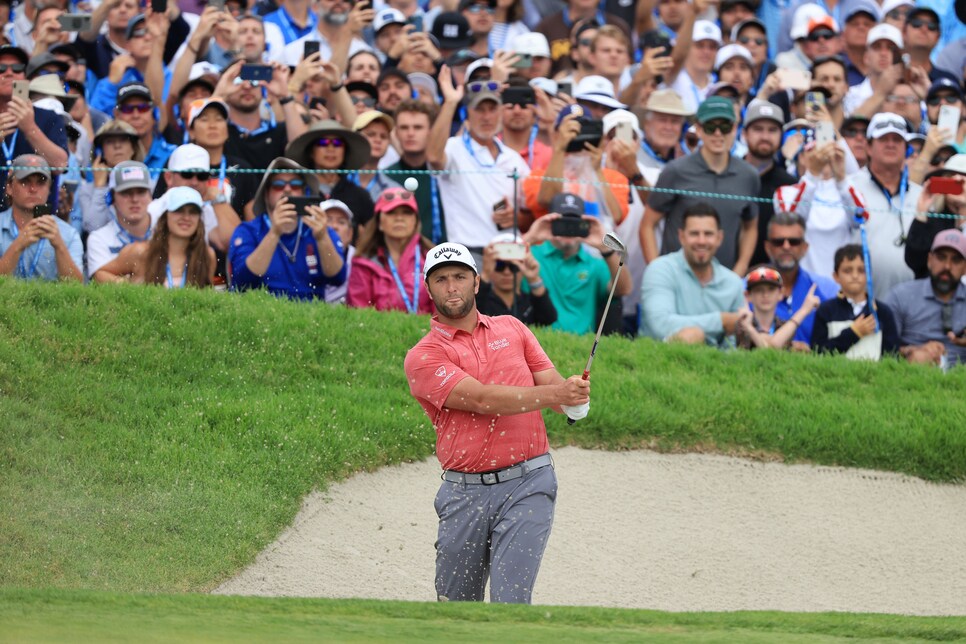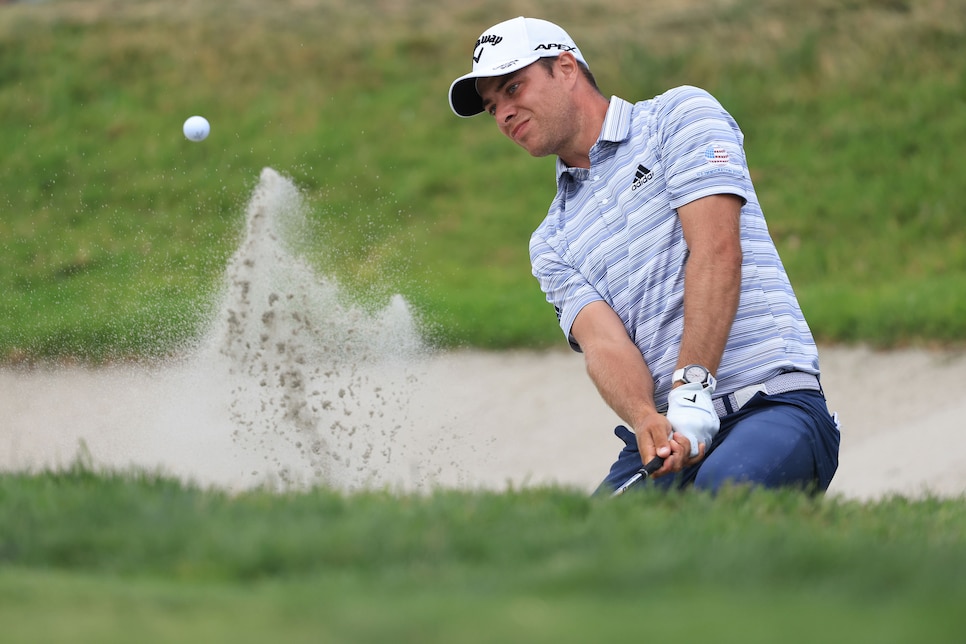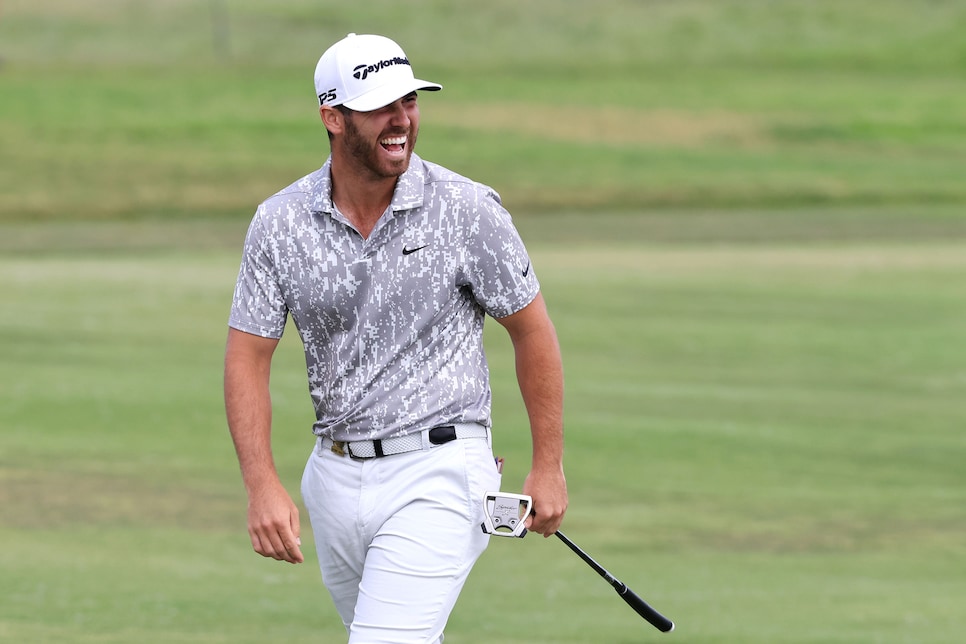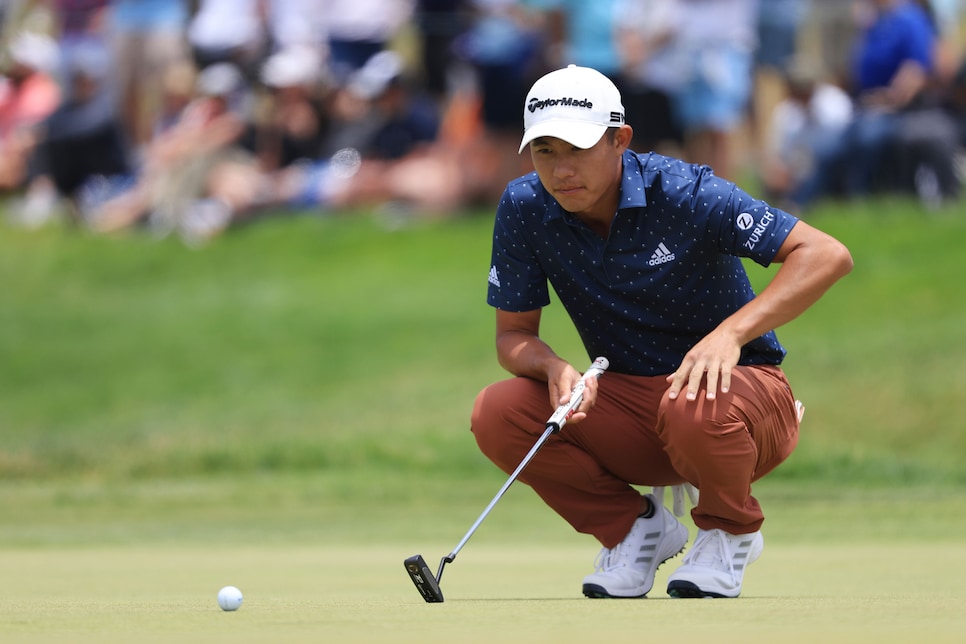Even the most ambitious youngster would have a hard time dreaming up Jon Rahm’s reality yesterday at Torrey Pines. The 26-year-old birdied the 17th and 18th holes to win his first Major championship and become the first Spaniard to win the US Open. He took over as world No.1 in the process… at the same spot he proposed to his wife… on his first Father’s Day as a dad… two weeks after he made international news for a brutally timed positive COVID test.
Rahm emerged the last man standing from a punch-drunk final day in San Diego, his final-round 67 good for a one-shot victory over the perennially second Louis Oosthuizen. For one last look back at a dramatic and chaotic week, here are 18 parting thoughts on the year’s third Major.
1: We start, as always, with the winner. As mentioned above, Rahm’s victory resembles a Hollywood script for a number of reasons. But we’re going to focus on something far less romantic: the distinctly unemotional decision he made in the most crucial moment.
Rahm was tied for the lead as he sent his second shot into the green on the par-5 18th hole. His ball kicked pretty hard right before resting on a downslope of the bunker, with the green sloping away from him and towards a pond. The temptation there is to try to nip a spinner right at the flag and leave yourself a kick-in birdie. As one of the better bunker players on earth, Rahm is absolutely capable of that shot. But it’s also a hugely risky undertaking, for the consequences of a not-perfect shot could be dire.
It’s so difficult to think of the negative in that moment. Rahm had just gutted a winding birdie putt on 17 and screamed at the top of his lungs when it dropped. His veins were overflowing with adrenaline. He’d waited his whole life for this moment, an up-and-down birdie to likely win the US Open… and he had the discipline to pull himself out of dreamland and acknowledge that he might not hit that bunker shot perfectly – and if he doesn’t, he brings disaster into play.

So he made the mature if unsexy decision, played safely right of the flag, eliminated the water from the equation and gave himself an 18-footer for birdie. He’s not likely to hole that putt – the PGA Tour make percentage from that distance is roughly 17 percent – but he made sure he had a birdie chance, which is what made it the smart choice from a probability standpoint. He wasn’t taking a knee or accepting par; he made the decision that gave him the best chance to make the lowest score considering all possible outcomes from the bunker shot. Of course, it looked genius when the putt fell in dead-centre, but it was the right call either way. Little moments like those often serve as the differentiator in a 72-hole event, and Rahm handled a high-leverage situation perfectly.
RELATED: The clubs Jon Rahm used to win the US Open
2: That’s now six runner-up finishes at Majors for Louis Oosthuizen, and along with his playoff loss to Bubba Watson at the 2012 Masters, this one might sting most. The shot he hit on the 17th tee – a pull into the canyon when there were acres and acres of turf right of the fairway – will not soon fade from his memory.
In turn, his reputation for near-misses only grows, which is equal parts amazing and unfortunate. One does not simply rack up seven top-two finishes in Majors; that’s the same number Brooks Koepka has, and more than Jordan Spieth and Rory McIlroy. Oosthuizen is an incredible player who shows up time and again in the sport’s biggest events, but we’re running out of justifications for his down-the-stretch tumbles. That he still hasn’t won a PGA Tour event since the 2010 Open Championship remains one of the crazier realities in golf.
3: For a while there, this leaderboard featured the most superstar contenders we’ve seen on a Major Sunday since the 2019 Masters. At roughly 1pm local time, there were 11 guys within three shots of the lead – including Oosthuizen, Rahm, McIlroy, Bryson DeChambeau, Collin Morikawa, Justin Thomas, Brooks Koepka and Dustin Johnson. At 2pm, there were 10 guys within a shot. So many big names being in the mix, coupled with the return of fans, made this year’s final round umpteen times more enjoyable to watch than last year at Winged Foot, where the last afternoon was dominated by has-Bryson-solved-golf? chatter. This was markedly less existential, in a great way.
4: And then, about an hour later, it descended into pure and utter mayhem. Major-Sunday pressure never fails to torment even the best players in the world. As soon as the 18th hole enters the line of sight, guys start moving in reverse. You had Morikawa blading a wedge shot over a green on 13. Bryson shooting a back-nine 44. Mackenzie Hughes lodging balls in trees. Koepka bogeying a par 5 to finish. It’s not the first time we’ve seen the tenor of a final round completely flip when it gets to winning time, but this tempo change rang particularly loud.
5: On Saturday night, I received this text from a player at Torrey: “Bryson is going to win this. And it’s gonna be like this for years if they don’t change the setup a bit.” A tad fatalistic, perhaps, but it does speak to a growing trend at the US Open.
Last year, Winged Foot played straight into the bombers’ hands. Those fairways were nearly impossible to hit, and when everyone is constantly in the rough, being closer is simply a huge advantage. Torrey’s fairways weren’t quite so hard to find – the kikuyu gives them that soft first bounce, and they’re not as canted – and while some non-bombers were able to hang this week, it felt like no coincidence that Rahm, Bryson, Brooks, Wolff, Rory and Co. bashed their way into contention. The identity of this championship, as Paul Azinger pointed out ad nauseum, has shifted from accuracy-first to power-first. It’s not necessarily a good or bad thing, but it’s a true thing, and it’ll be fascinating to see the setups at The Country Club next year and Los Angeles Country Club in 2023. Rough doesn’t feature quite so prominently at either of those courses, but in the post-Chambers Bay, post-Erin Hills years, the USGA has stuck with a narrow-fairway-brutal-rough-formula. We’ll see if it continues.
6: Despite his back-nine implosion, DeChambeau has mastered the art – er, science? – of bomb-and-gouge. If that name offends you, we’ll go with bomb-and-reassess. Becoming a beefed-up Bryson wasn’t just about adding speed and distance, but also vowing to fully commit to a new strategy. It’s not just that he’s hitting it farther, it’s that he hits driver wherever it’s even semi-feasible. The data supports this strategy. You wallop driver off the tee. If you find the fairway, you attack. If you don’t, you shift your focus to making par. And DeChambeau is able to do this better than basically anyone for two main reasons. One, his sheer strength allows him to muscle balls out of rough that other guys cannot. Two, his single-length irons mean his wedge and short irons are longer than most, allowing him to get some extra speed and steepness into the ball, which are crucial to rescuing balls from calf-high cabbage.

And while it may not be the most aesthetically pleasing method to make your way around a golf course, nor is it the type of game Bobby Jones or Ben Hogan played, it’s paying huge dividends at tough courses with penal rough. Places like Winged Foot and Torrey Pines, yes, but also Bay Hill, where DeChambeau won earlier this year. How it’ll work at Royal St. George’s, where the wind is always a factor, is anyone’s guess. We have yet to see Beefy Bryson bring his experiment to a links course, and the juxtaposition between the ancient courses and his distinctly modern game present a fascinating dynamic.
7: Rahm speaks better English than 99 percent of Americans. Maybe 99.9 percent. A non-golfer friend reached out to ask if Rahm’s first language is English, for he couldn’t possibly have that kind of mastery of his second language. Only he does. Rahm knew very little English when he arrived at Arizona State University in late 2012, and he’s now a master of irony and sarcasm and pacing and dramatic pauses. On Tuesday, he eloquently explained why he supported the PGA Tour’s handling of the Memorial situation. Yesterday, after Oosthuizen failed to eagle the 18th, he waxed poetic about why Torrey Pines holds such a special place in his heart. It could’ve been an ad for Rosetta Stone.
8: Guido Migliozzi’s name could not be more fun to say. Nor could it be more Italian, which led to some delightful GIFs and memes and “Inglourious Basterds” references. (Enzo Gorlami! Dominic Decoco!) Migliozzi, however, was anything but a side show in his Major-championship debut. The 24-year-old fist-pumped his way to a top-four finish, which gets him into next year’s US Open and the Masters. He came into this week off back-to-back runner-up finishes in Europe and kept the momentum cooking on the other side of the pond. A hugely impressive week for a promising young player who will join Francesco Molinari in representing his country at the Olympics.

9: A half-baked idea: Golf tournaments should have a little screen next to the tee that shows radar data from tee shots. Imagine if, after a Bryson bomb, the fans could see “192mph ball speed” and, a few seconds later “332-yard carry”. Something tells me some well-served patrons would get a kick out of that. It’d be similar to the pitch speed and exit velocity Major League Baseball teams show in their stadiums. The only potential snag in this genius plan is it would tell players how far their ball is flying on a certain day, which feels like something of an unnatural advantage. Ehhhhh. Not that big of a deal. Let’s make it happen.
10: Richard Bland – complete with grey stubble, a four-year-old driver and his home course’s logo on his hat – put a smile on all our faces for two-plus days. The 48-year-old, winless in his first 477 European Tour starts before finally grabbing a victory last month, held a share of the lead at the halfway point, providing our latest example of just how beautifully unpredictable this game is. To see him up there was a genuine shock… until you saw him swing the club. As good a move as anyone’s. It was yet another reminder of just how many great, great golfers there are lurking beneath the surface in professional golf.
What he said on Friday afternoon stuck with us: “The old saying is you get knocked down seven times, you get up eight. I’ve always had that kind of attitude that you just keep going. You never know in this game. You just keep going.”
How relatable is that? You truly, truly never know. We’ll play our best round ever and then stink the next time out. Hit terrible shots all day, then pure two in a row for a kick-in birdie. Most professionals feel similarly. There is an element of chaos in golf that borders on randomness. It’s part of what makes this torturous game so great.

11: Torrey Pines took quite a beating this week. The wonkier corners of Golf Twitter were dominated by debate over Torrey’s worthiness as a US Open course. We see both sides. On one hand, Torrey did not benefit from falling directly after Kiawah’s Ocean Course, one of the more visually distinct and intriguing designs in the United States. It’s uncanny how many holes at Torrey are just long and straight, with bunkers on both sides of the fairway landing area and both sides of the green. Apart from holes three and 18, there aren’t really any holes you immediately recognise because they’re all so similar. On the other hand: not every golf course can be breathtakingly beautiful and unique, and one measure of a tournament venue is the leaderboard it produces. This one was loaded.
Two things can be true at once: Torrey is not a bucket-list golf course, and it served its purpose as a US Open host venue. The lack of complaining spoke volumes as far as player satisfaction with the golf course. Here’s what Phil Mickelson, who has not held back from ripping into the USGA in years past, had to say about the setup: “I’m very surprised that, in the 30 years I’ve played the US Open, this is the best I’ve seen. I thought they did a remarkable job, and I’m really proud and happy that it’s here at Torrey.” That’s not for nothing.
12: One more Torrey note. It’s hard not to love what the USGA did with the par-3 third on Friday, when it was converted from a 195-yard mid-iron to a 134-yard wedge. There is no feeling in golf quite like seeing your ball flying towards the flag but not being sure exactly where it’s going to plop down. Short, in the bunker? A solid 40 feet past the flag? Or, ideally, right next to the stick? Short, downhill par 3s are a factory for please-be-good-type shots because it’s quite tricky to figure out just how much mustard to take off, and it was terrific watching guys hoping (praying?) their ball carried the correct weight. Plus, having the Pacific swirling in the background only added to the intrigue.
13: How great was it to see Matthew Wolff play so well this week? And, more importantly, enjoying himself in the process? It does feel we’re at a bit of an inflection point regarding athletes and mental health – Naomi Osaka has played a major role in shaping the conversation – and Wolff’s ability to return like this, after all that time off, will surely inspire more players struggling internally to consider stepping away for a bit. Which, of course, is great. Golf tortures all of us who play it for fun; imagine the mental toll it takes on guys who play it for dollars.
Wolff wasn’t the only one this week to candidly discuss the mental anguish this game wreaks. Here was Bubba Watson, after shooting four-under 67 on Friday: “I’m going to be dead honest with you. Don’t tell nobody, this is a secret. I am nervous over every shot, OK? … I don’t know what’s going on. I’m so nervous.” And, a day later, 19-year-old Akshay Bhatia: “I just have a hard time enjoying myself and understanding the opportunity I created for myself and just the atmosphere. I should enjoy it a lot more than I do. I just didn’t have fun today, which really sucks because a lot of golf is score-oriented, and when you’re not playing well, it feels like it sucks, but I can’t do anything about it.”
That’s hard to read, coming from a teenager who’s living out his dream. But the first step towards improvement is acknowledging the problem, and more and more guys are open to doing exactly that. It’s wonderful to see.

14: An interesting, inside-golf problem that could use addressing. A number of Korn Ferry players were in the field this week and did not receive any Korn Ferry Tour points for their performance. This may sound like the obvious outcome – the US Open is not a Korn Ferry Tour event – but should guys really be punished for playing their way into a Major?
Consider Taylor Montgomery, who got into the field through the southern California qualifying site. He came into this week ranked 24th on the KFT points list, with the top 25 getting PGA Tour cards at the end of the regular season in August. Montgomery made the cut in the US Open. And he dropped to 28th on the KFT list because he didn’t play in the tournament that was going on simultaneously in Wichita, Kansas. The same is true for Dylan Wu, who came into the week 28th on the KFT, finished T-31 at Torrey, and will be further from his PGA Tour card as a result. This feels like a no-brainer; create some points scale to award players who get into Majors and play well in them.
15: Announcers can’t stop, won’t stop saying “this, from a minute ago”. It’s a reasonable thing to say if journalistic integrity is your No.1 goal. But this is entertainment, and every time a broadcaster says that we know something is about to happen. If it’s a guy way out of contention putting from 60 feet, you know it’s going down. If it’s a shot from the fairway, you know it’s going to flirt with the flag. A huge part of what makes watching sports on TV so fun is not knowing what’s going to happen. So, stop telling us this was from a moment a go. Lie to us. We’re giving you permission to do so. For entertainment’s sake.
16: Super aggressive, yell-at-the-top-of-your-lungs fist pumps have their place. But so do understated, muted fist-clenches. They feel a bit more intimate. More inwardly focused. Less let’s goooo and more come on, we can do this. Rory McIlroy delivered a perfect one after holing a birdie putt on the fourth green yesterday.
17: Different week, same story for Collin Morikawa. The 24-year-old has emerged as the premier iron player in the world, and the gap between him and everyone else is widening. Morikawa leads the PGA Tour in strokes gained/approach and strokes gained/tee-to-green this season, and so he’s able to contend week-in, week-out despite losing strokes in putting most weeks. At Torrey, he led the field in strokes gained/tee-to-green and finished T-5 despite losing half a shot to the field in putting.
About that putting… it seems the best putters get up there, have a look, maybe a practice stroke or two, and go. Morikawa often looks frozen as he stands over the ball, and while we can’t pretend to know exactly the reason, most instructors will tell you nothing good happens in those extra still moments. If he ever figures out the flatstick, he will become No.1 in the world shortly thereafter. But it’s a not-small if.

18: After a one-year COVID hiatus, the US Open once again had qualifiers in the field, and the tournament was much better off for it. USGA officials love to point out that playing your way into America’s national championship is “part of the US Open’s DNA” but the slightly canned talking point is so true. Last year’s all-exempt field lacked the charming stories of off-the-radar guys who earned their week in the sun. Take Kyle Westmoreland, the first graduate of the Air Force Academy to make a cut in the US Open. Or Bhatia, the 19-year-old former junior prodigy who made the cut on the number. Or Wu and Montgomery and Greyson Sigg, who showed that Korn Ferry Tour players can hang with the big boys. The best finish at Torrey by a qualifier? That would be Branden Grace with a tie for seventh. Not exactly an underdog story, as the South African has played on three Presidents Cup teams, remains the only man to shoot 62 in a Major and once sat inside the top 10 of the world ranking. But his game has been in a tough spot for a few years, and so he had to qualify for this tournament – because golf is the ultimate meritocracy, and the US Open is the most meritocratic tournament of them all.
TOP PHOTO: Ezra Shaw

